Effect of Cyclic Stretch on Vascular Endothelial Cells and Abdominal Aortic Aneurysm (AAA): Role in the Inflammatory Response
Abstract
1. Introduction
2. Results
2.1. Relationship between Wall Stress and Degree of Calcification
2.2. Correlation between Calcium Deposition and Inflammation
2.3. Oxidative Stress Proteins Are Overexpressed in AAA
2.4. Mechanical Stimulation Drives ROS/Superoxide Production in EA.hy926
2.5. Strain Affects CD62E Expression and Monocytes Adhesion
2.6. Strain Affects MMP-9 Expression and Activity in ECs
3. Discussion
4. Materials and Methods
4.1. Patients and Healthy Donors’ Enrollment
4.2. AAA Patients: Calcification Modeling and Wall Dilatation
4.3. Histological Analyses on Human Aortic Samples
4.4. Proteomic Analysis
4.5. Dynamic Cell Culture
4.6. Phalloidin Staining
4.7. Cellular ROS/Superoxide Detection Assay Kit
4.8. Immunofluorescence
4.9. Leukocyte-Endothelium Adhesion Assay
4.10. Western Blot
4.11. Zymography Assay
4.12. Statistical Analyses
5. Conclusions
Author Contributions
Funding
Acknowledgments
Conflicts of Interest
Abbreviations
| AAA | Abdominal aortic aneurysm |
| ECs | Endothelial cells |
| TNF-α | Tumor necrosis factor alpha |
| MMP-9 | Matrix metalloproteinase -9 |
| ECM | Extracellular matrix |
| PTM | Transmural pressure |
| vSMCs | Vascular smooth muscle cells |
| IL-1 | Interleukin-1 |
| IL-6 | Interleukin-6 |
| IL-8 | Interleukin-8 |
| MCP-1 | Monocyte chemoattractant protein 1 |
| RANTES | Regulated on activation, normal T cell expressed and secreted |
| CAMs | Cell adhesion molecules |
| ROS | Reactive oxygen species |
| NADPH | Nicotinamide adenine dinucleotide phosphate |
| NOX | Nicotinamide adenine dinucleotide phosphate oxidase |
| XO | Xanthine oxidase |
| SOD | Superoxide dismutase |
| TRX | Thioredoxin |
| MMPs | Matrix metalloproteinases |
| NF-kB | Nuclear factor kappa-light-chain-enhancer of activated B cells |
| AP-1 | Activator protein 1 |
| CAT | Computed axial tomography |
| CDs | Clusters of differentiation |
| AAC | Aortic aneurysm calcification |
| OPN | Osteopontin |
| LC-MS | Liquid chromatography-mass spectrometry |
| CATA | Catalase |
| SODM | Superoxide dismutase (Mn), mitochondrial |
| PDIA1 | Protein disulfide-isomerase |
| PERM | Isoform H14 of myeloperoxidase |
| CERU | Ceruloplasmin |
| FRIH | Ferritin heavy chain |
| FRIL | Ferritin light chain |
| RNS | Reactive nitrogen species |
| FACS | Fluorescence-activated cell sorting |
| CD62E | E-selectin |
| PBMCs | Peripheral blood mononuclear cells |
| OSR | Open surgical repair |
| DAAA | Diameter of abdominal aortic aneurysm |
| RIPA | Radioimmunoprecipitation buffer |
| EDTA | Ethylenediaminetetraacetic acid |
| EGTA | Ethyleneglycol-bis(2-aminoethylether)-N,N,N′,N′-tetraacetic acid |
| TFE | Trifluoroethanol |
| DTT | Dithiothreitol |
| IAM | Iodoacetamide |
| SPE | Solid phase extraction |
| LC-MS/MS | Liquid chromatography-tandem mass spectrometry |
| TOF | Time of flight |
| CDS | Calibrant delivery system |
| DDA | Data-dependent acquisition |
| DIA | Data independent analysis |
| ESi-QUAD-TOF | Electrospray ionization-quadrupole-time of flight |
| DMEM | Dulbecco’s modified Eagle’s medium |
| TRITC | Tetramethylrhodamine |
| DAPI | 4′,6-Diamidine-2′-phenylindole dihydrochloride |
| PBS | Phosphate buffered saline |
| SDS-PAGE | Sodium dodecyl sulfate polyacrylamide gel electrophoresis |
References
- Moxon, J.V.; Parr, A.; Emeto, T.I.; Walker, P.; Norman, P.E.; Golledge, J. Diagnosis and Monitoring of Abdominal Aortic Aneurysm: Current Status and Future Prospects. Curr. Probl. Cardiol. 2010, 35, 512–548. [Google Scholar] [CrossRef] [PubMed]
- Forsdahl, S.H.; Singh, K.; Solberg, S.; Jacobsen, B.K. Risk factors for abdominal aortic aneurysms: A 7-year prospective study: The tromsø study, 1994–2001. Circulation 2009, 119, 2202–2208. [Google Scholar] [CrossRef] [PubMed]
- Vardulaki, K.A.; Prevost, T.C.; Walker, N.M.; Day, N.E.; Wilmink, A.B.M.; Quick, C.R.G.; Ashton, H.A.; Scott, R.A.P. Incidence among men of asymptomatic abdominal aortic aneurysms: Estimates from 500 screen detected cases. J. Med. Screen. 1999, 6, 50–54. [Google Scholar] [CrossRef] [PubMed]
- Lederle, F.A.; Johnson, G.R.; Wilson, S.E.; Littooy, F.N.; Krupski, W.C.; Bandyk, D.; Acher, C.W.; Chute, E.P.; Hye, R.J.; Gordon, I.L.; et al. Yield of repeated screening for abdominal aortic aneurysm after a 4-year interval. Arch. Intern. Med. 2000, 160, 1117–1121. [Google Scholar] [CrossRef] [PubMed]
- Scott, R.A.P.; Ashton, H.A.; Buxton, M.J.; Day, N.E.; Kim, L.G.; Marteau, T.M.; Thompson, S.G.; Walker, N.M. The Multicentre Aneurysm Screening Study (MASS) into the effect of abdominal aortic aneurysm screening on mortality in men: A randomised controlled trial. Lancet 2002, 360, 1531–1539. [Google Scholar] [CrossRef]
- Lindholt, J.S.; Juul, S.; Fasting, H.; Henneberg, E.W. Screening for abdominal aortic aneurysms: Single centre randomised controlled trial. Br. Med. J. 2005, 330, 750–752. [Google Scholar] [CrossRef] [PubMed]
- Ashton, H.A.; Gao, L.; Kim, L.G.; Druce, P.S.; Thompson, S.G.; Scott, R.A.P. Fifteen-year follow-up of a randomized clinical trial of ultrasonographic screening for abdominal aortic aneurysms. Br. J. Surg. 2007, 94, 696–701. [Google Scholar] [CrossRef] [PubMed]
- Nordon, I.M.; Hinchliffe, R.J.; Loftus, I.M.; Thompson, M.M. Pathophysiology and epidemiology of abdominal aortic aneurysms. Nat. Rev. Cardiol. 2011, 8, 92–102. [Google Scholar] [CrossRef]
- Rodella, L.F.; Rezzani, R.; Bonomini, F.; Peroni, M.; Cocchi, M.A.; Hirtler, L.; Bonardelli, S. Abdominal aortic aneurysm and histological, clinical, radiological correlation. Acta Histochem. 2016, 118, 256–262. [Google Scholar] [CrossRef]
- Galora, S.; Saracini, C.; Palombella, A.M.; Pratesi, G.; Pulli, R.; Pratesi, C.; Abbate, R.; Giusti, B. Low-density lipoprotein receptor-related protein 5 gene polymorphisms and genetic susceptibility to abdominal aortic aneurysm. J. Vasc. Surg. 2013, 58, 1062–1068. [Google Scholar] [CrossRef]
- Emeto, T.I.; Moxon, J.V.; Biros, E.; Rush, C.M.; Clancy, P.; Woodward, L.; Moran, C.S.; Jose, R.J.; Nguyen, T.; Walker, P.J.; et al. Urocortin 2 is associated with abdominal aortic aneurysm and mediates anti-proliferative effects on vascular smooth muscle cells via corticotrophin releasing factor receptor 2. Clin. Sci. 2014, 126, 517–527. [Google Scholar] [CrossRef] [PubMed]
- Wassef, M.; Baxter, B.T.; Chisholm, R.L.; Dalman, R.L.; Fillinger, M.F.; Heinecke, J.; Humphrey, J.D.; Kuivaniemi, H.; Parks, W.C.; Pearce, W.H.; et al. Pathogenesis of abdominal aortic aneurysms: A multidisciplinary research program supported by the National Heart, Lung, and Blood Institute. J. Vasc. Surg. 2001, 34, 730–738. [Google Scholar] [CrossRef] [PubMed]
- Buijs, R.V.C.; Willems, T.P.; Tio, R.A.; Boersma, H.H.; Tielliu, I.F.J.; Slart, R.H.J.A.; Zeebregts, C.J. Calcification as a risk factor for rupture of abdominal aortic aneurysm. Eur. J. Vasc. Endovasc. Surg. 2013, 46, 542–548. [Google Scholar] [CrossRef] [PubMed]
- Lederle, F.A.; Johnson, G.R.; Wilson, S.E.; Gordon, I.L.; Chute, E.P.; Littooy, F.N.; Krupski, W.C.; Bandyk, D.; Barone, G.W.; Graham, L.M.; et al. Relationship of age, gender, race, and body size to infrarenal aortic diameter. J. Vasc. Surg. 1997, 26, 595–601. [Google Scholar] [CrossRef]
- Chiu, J.-J.; Chien, S. Effects of dsisturbed flow on vascular endothelium: Pathophysiological basis and clinical perspectives. Physiol. Rev. 2011, 91, 327–387. [Google Scholar] [CrossRef] [PubMed]
- Wang, D.H.; Makaroun, M.S.; Webster, M.W.; Vorp, D.A. Effect of intraluminal thrombus on wall stress in patient-specific models of abdominal aortic aneurysm. J. Vasc. Surg. 2002, 36, 598–604. [Google Scholar] [CrossRef] [PubMed]
- Li, Z.Y.; U-King-Im, J.; Tang, T.Y.; Soh, E.; See, T.C.; Gillard, J.H. Impact of calcification and intraluminal thrombus on the computed wall stresses of abdominal aortic aneurysm. J. Vasc. Surg. 2008, 47, 928–935. [Google Scholar] [CrossRef]
- Davies, P.F. Flow-Mediated Endothelial Mechanotransduction. Physiol. Rev. 1995, 75, 519–560. [Google Scholar] [CrossRef]
- Kofler, S.; Nickel, T.; Weis, M. Role of cytokines in cardiovascular diseases: A focus on endothelial responses to inflammation. Clin. Sci. 2005, 108, 205–213. [Google Scholar] [CrossRef]
- Mackay, C.R. Chemokines: Immunology’s high impact factors. Nat. Immunol. 2001, 2, 95–101. [Google Scholar] [CrossRef]
- Golias, C.H.; Tsoutsi, E.; Matziridis, A.; Makridis, P.; Batistatou, A.; Charalabopoulos, K. Leukocyte and endothelial cell adhesion molecules in inflammation focusing on inflammatory heart disease. In Vivo 2007, 21, 757–770. [Google Scholar] [PubMed]
- Tsutsui, H.; Kinugawa, S.; Matsushima, S. Oxidative stress and heart failure. Am. J. Physiol. Heart Circ. Physiol. 2011, 301, H2181–H2190. [Google Scholar] [CrossRef] [PubMed]
- McCormick, M.L.; Gavrila, D.; Weintraub, N.L. Role of oxidative stress in the pathogenesis of abdominal aortic aneurysms. Arterioscler. Thromb. Vasc. Biol. 2007, 27, 461–469. [Google Scholar] [CrossRef] [PubMed]
- Forstermann, U. Oxidative stress in vascular disease: Causes, defense mechanisms and potential therapies. Nat. Clin. Pract. Cardiovasc. Med. 2008, 5, 338–349. [Google Scholar] [CrossRef] [PubMed]
- Forstermann, U. Nitric oxide and oxidative stress in vascular disease. Pflugers Arch. 2010, 459, 923–939. [Google Scholar] [CrossRef] [PubMed]
- Parodi, F.E.; Mao, D.; Ennis, T.L.; Bartoli, M.A.; Thompson, R.W. Suppression of experimental abdominal aortic aneurysms in mice by treatment with pyrrolidine dithiocarbamate, an antioxidant inhibitor of nuclear factor-κB. J. Vasc. Surg. 2005, 41, 479–489. [Google Scholar] [CrossRef]
- Costanzo, A.; Moretti, F.; Burgio, V.L.; Bravi, C.; Guido, F.; Levrero, M.; Puri, P.L. Endothelial activation by angiotensin II through NFκB and p38 pathways: Involvement of NFκB-inducible kinase (NIK), free oxygen radicals, and selective inhibition by aspirin. J. Cell. Physiol. 2003, 195, 402–410. [Google Scholar] [CrossRef]
- Li, Q.; Engelhardt, J.F. Interleukin-1beta induction of NFkappaB is partially regulated by H2O2-mediated activation of NFkappaB-inducing kinase. J. Biol. Chem. 2006, 281, 1495–1505. [Google Scholar] [CrossRef]
- Ramella, M.; Bernardi, P.; Fusaro, L.; Manfredi, M.; Casella, F.; Porta, C.M.; Nicolai, L.; Galeazzi, E.; Boldorini, R.; Settembrini, A.M.; et al. Relevance of inflammation and matrix remodeling in abdominal aortic aneurysm (AAA) and popliteal artery aneurysm (PAA) progression. Am. J. Transl. Res. 2018, 10, 3265–3275. [Google Scholar]
- Ascoli Marchetti, A.; Pratesi, G.; Di Giulio, L.; Battistini, M.; Massoud, R.; Ippoliti, A. EVAR and OPEN treatment of abdominal aortic aneurysm: What is the role of MMP-9 in the follow-up? J. Med. Vasc. 2017, 42, 21–28. [Google Scholar] [CrossRef]
- Wang, Q.; Ren, J.; Morgan, S.; Liu, Z.; Dou, C.; Liu, B. Monocyte Chemoattractant Protein-1 (MCP-1) regulates macrophage cytotoxicity in abdominal aortic aneurysm. PLoS ONE 2014, 9, e92053. [Google Scholar] [CrossRef] [PubMed]
- Palmieri, D.; Perego, P.; Palombo, D. Estrogen receptor activation protects against TNF-α-induced endothelial dysfunction. Angiology 2014, 65, 17–21. [Google Scholar] [CrossRef] [PubMed]
- Zhang, H.; Park, Y.; Wu, J.; Chen, X.; Lee, S.; Yang, J.; Dellsperger, K.C.; Zhang, C. Role of TNF-alpha in vascular dysfunction. Clin. Sci. 2009, 116, 219–230. [Google Scholar] [CrossRef] [PubMed]
- Hadi, H.A.R.; Carr, C.S.; Al Suwaidi, J. Endothelial Dysfunction: Cardiovascular Risk Factors, Therapy, and Outcom. Vasc. Health Risk Manag. 2005, 1, 183–198. [Google Scholar] [PubMed]
- Ramella, M.; Boccafoschi, F.; Bellofatto, K.; Follenzi, A.; Fusaro, L.; Boldorini, R.; Casella, F.; Porta, C.; Settembrini, P.; Cannas, M. Endothelial MMP-9 drives the inflammatory response in abdominal aortic aneurysm (AAA). Am. J. Transl. Res. 2017, 9, 5485–5495. [Google Scholar] [PubMed]
- Golledge, J.; Muller, J.; Daugherty, A.; Norman, P. Abdominal aortic aneurysm: Pathogenesis and implications for management. Arterioscler. Thromb. Vasc. Biol. 2006, 26, 2605–2613. [Google Scholar] [CrossRef] [PubMed]
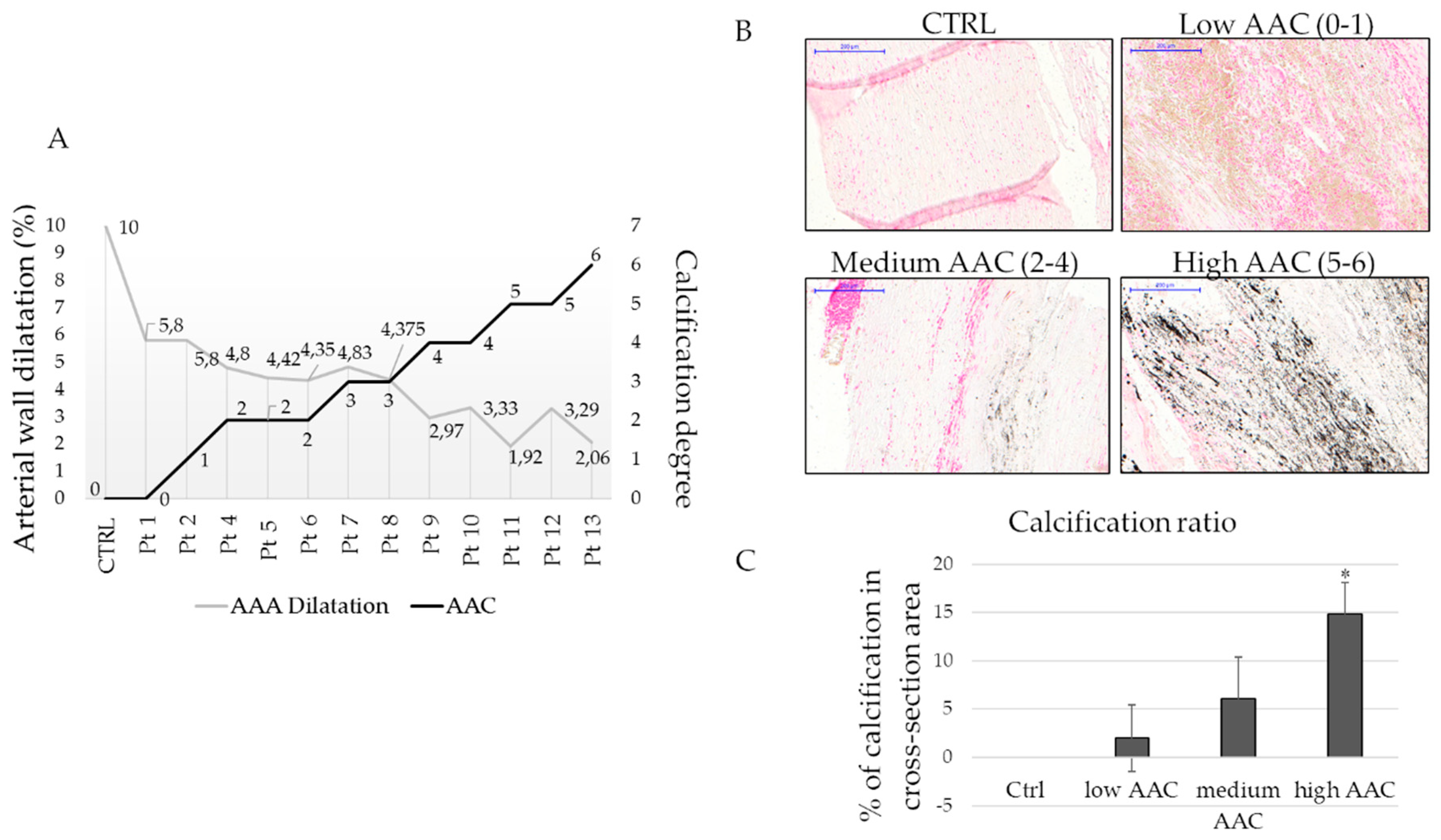
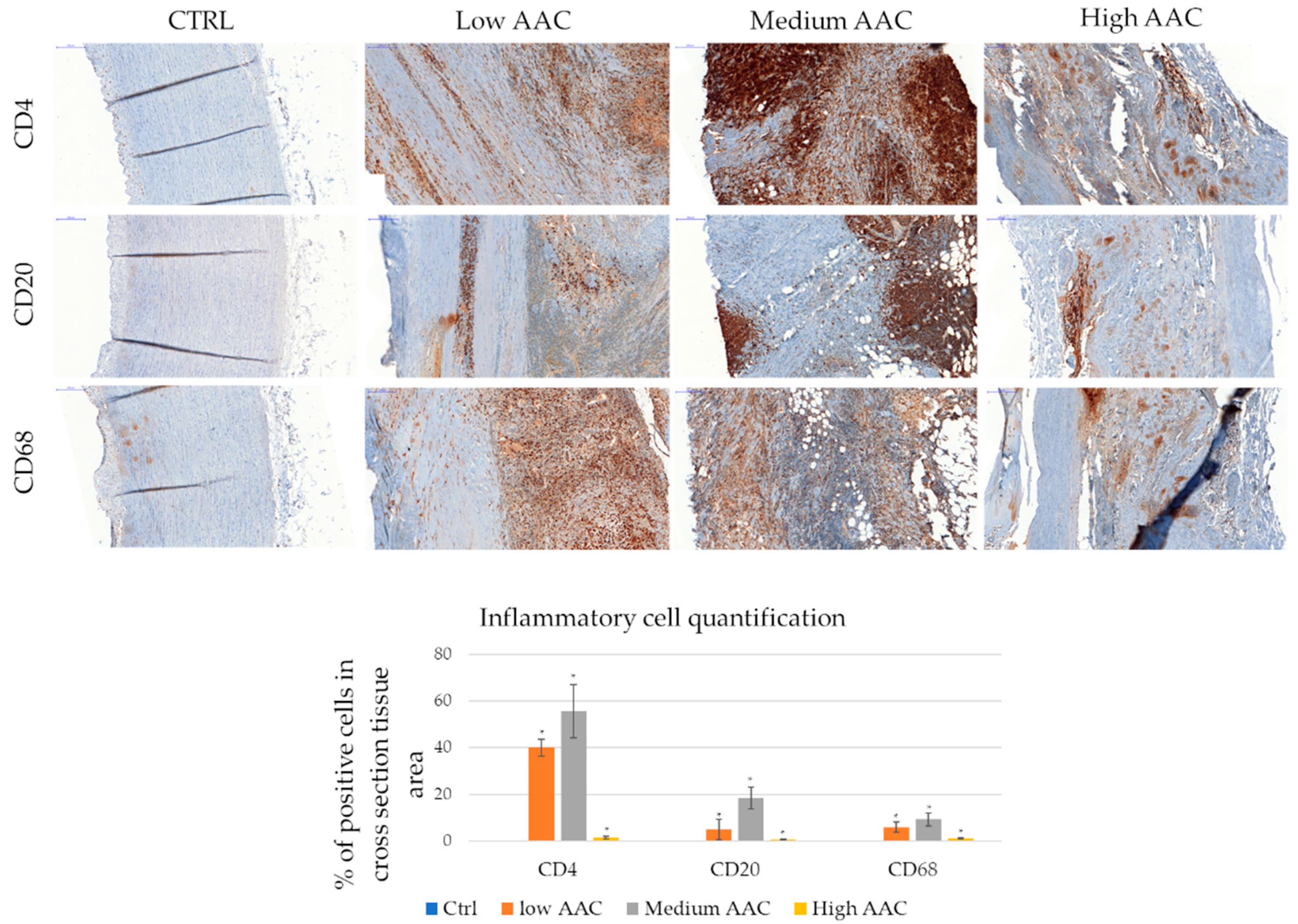
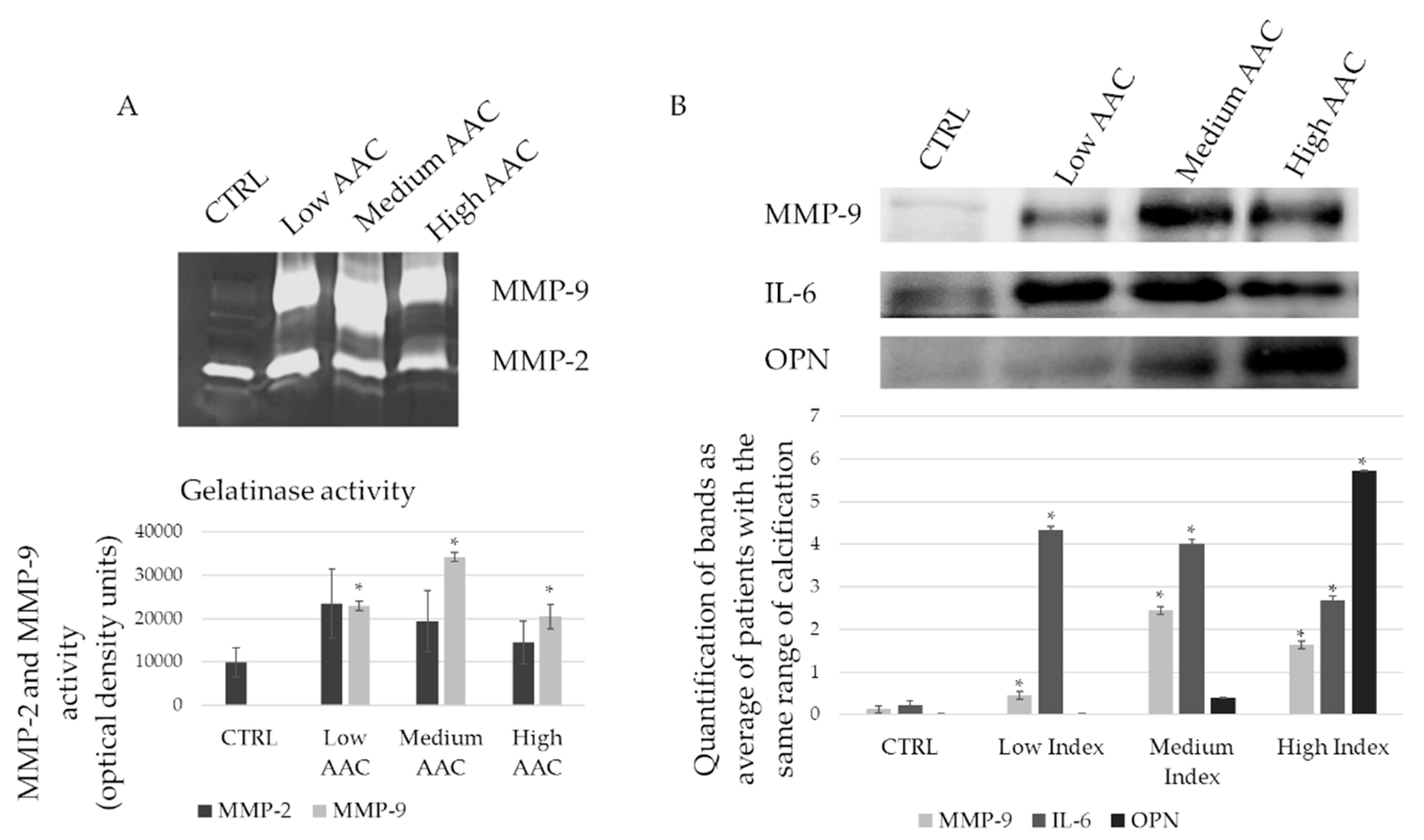
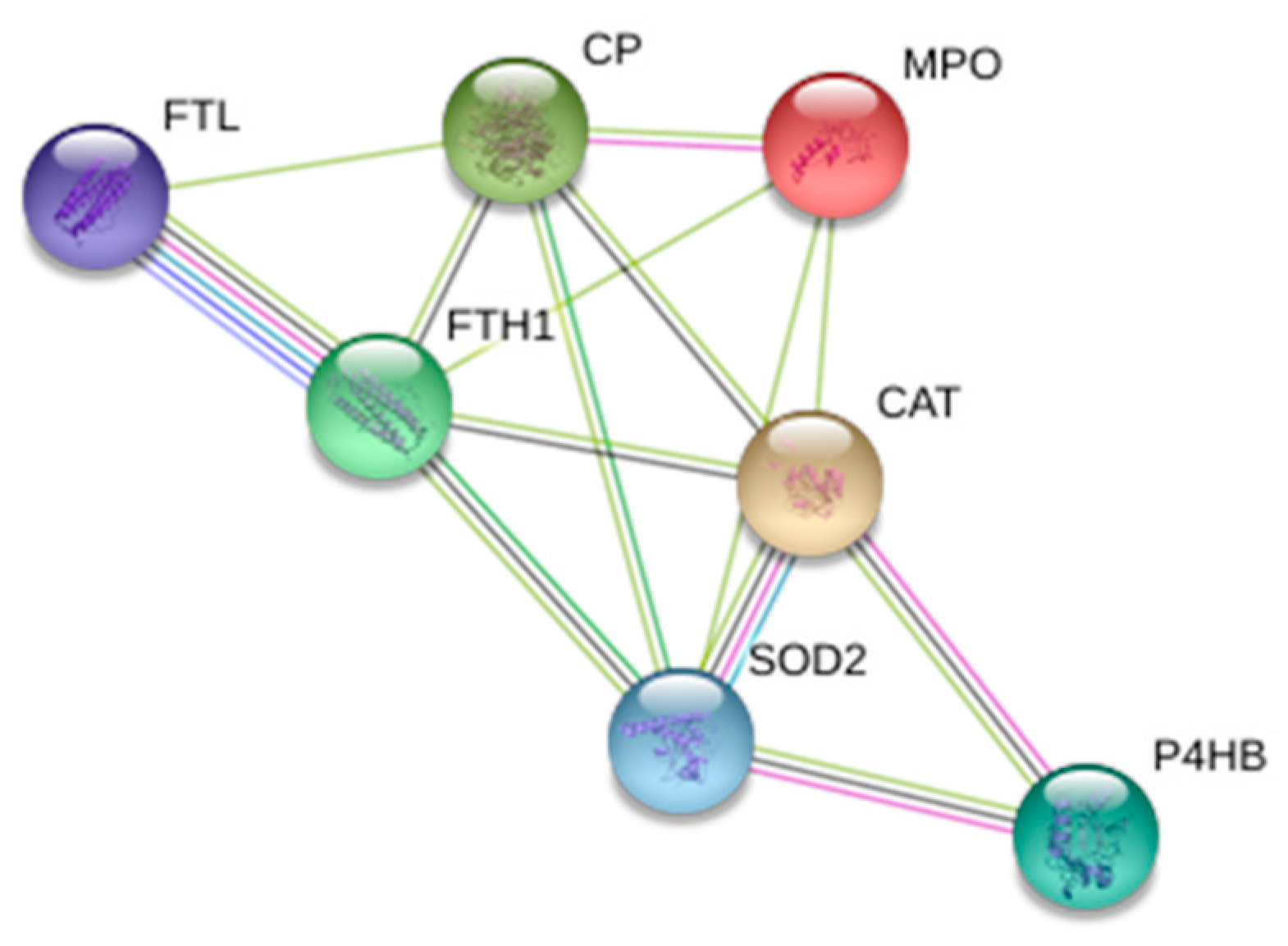
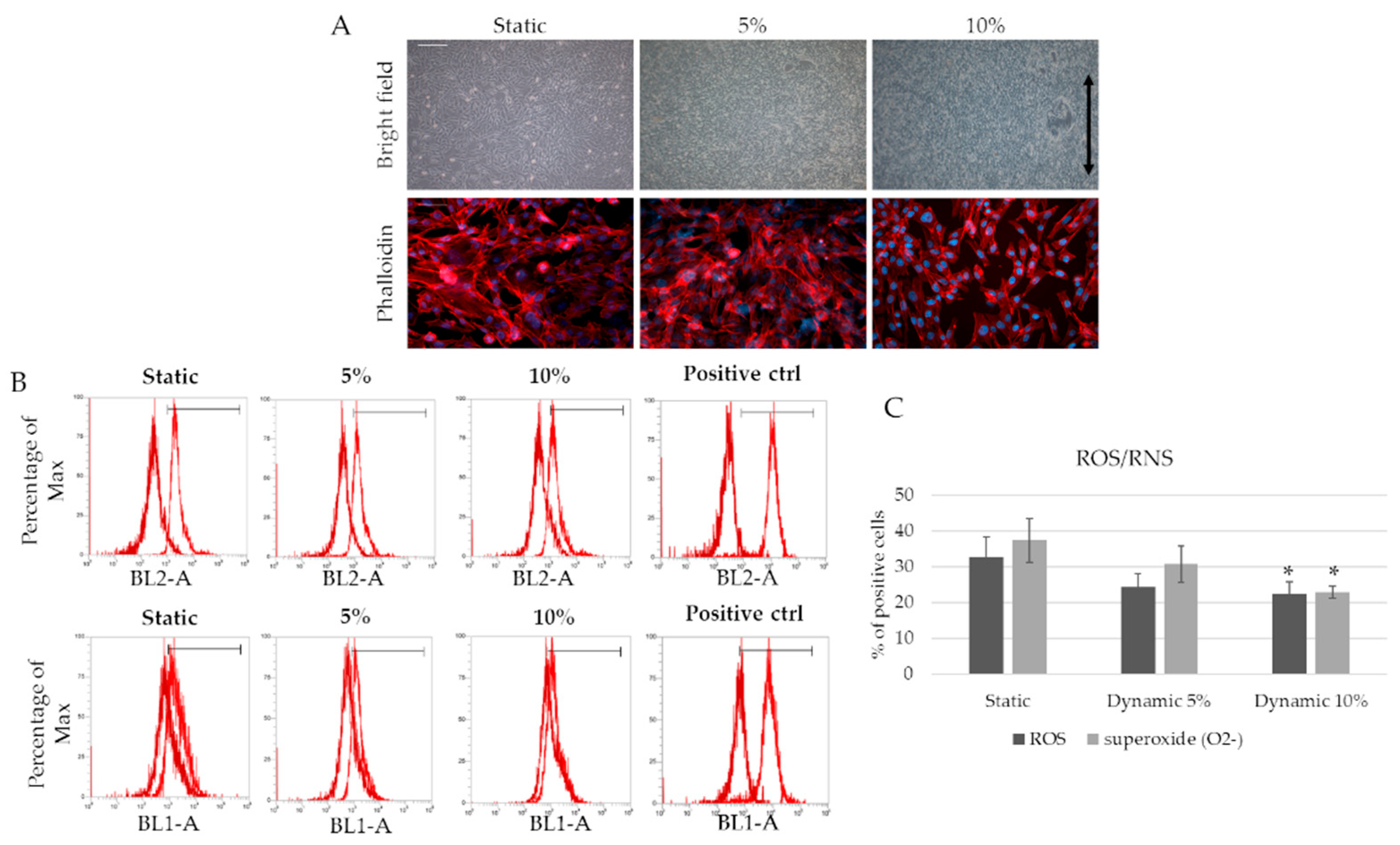
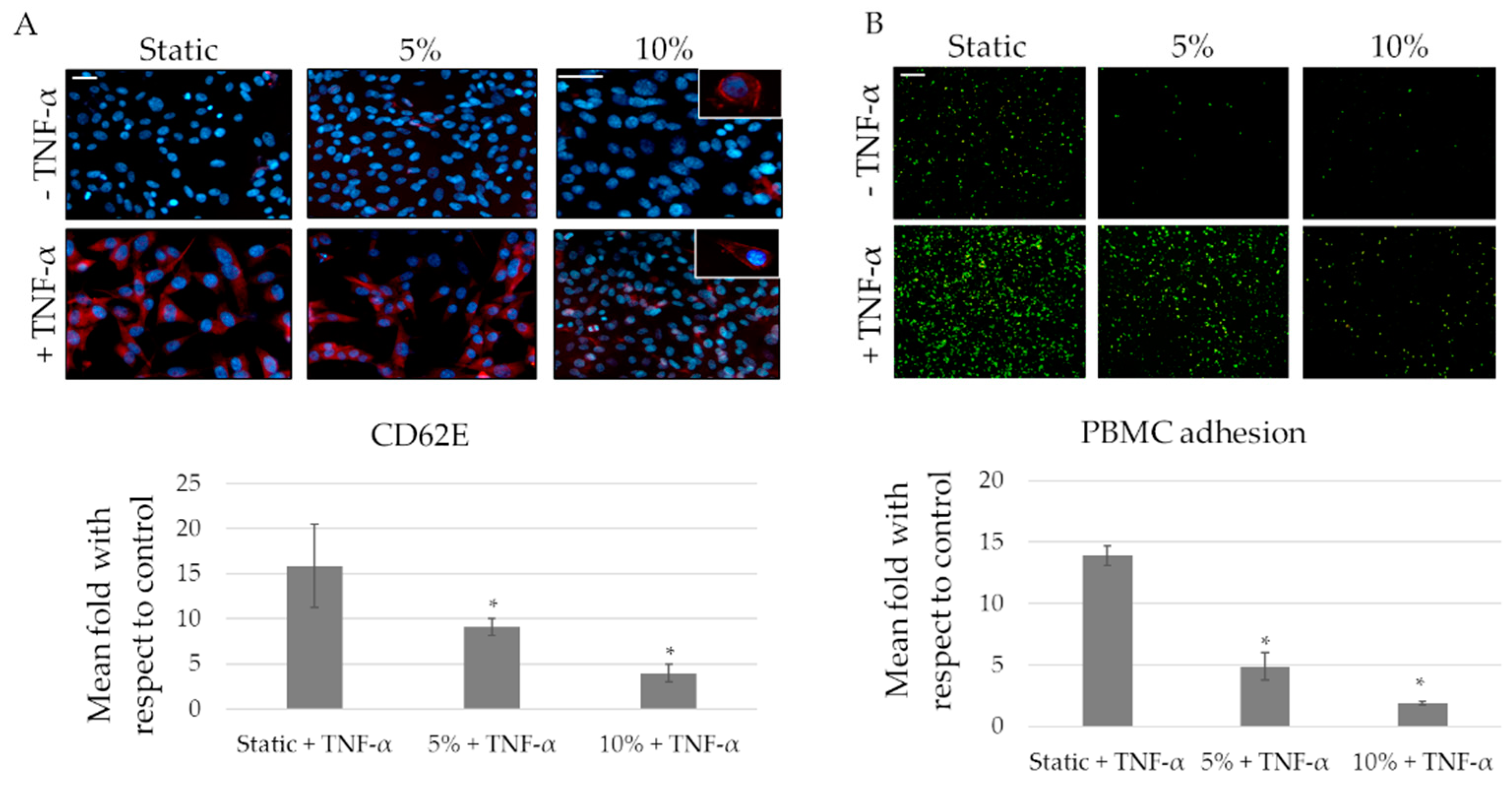
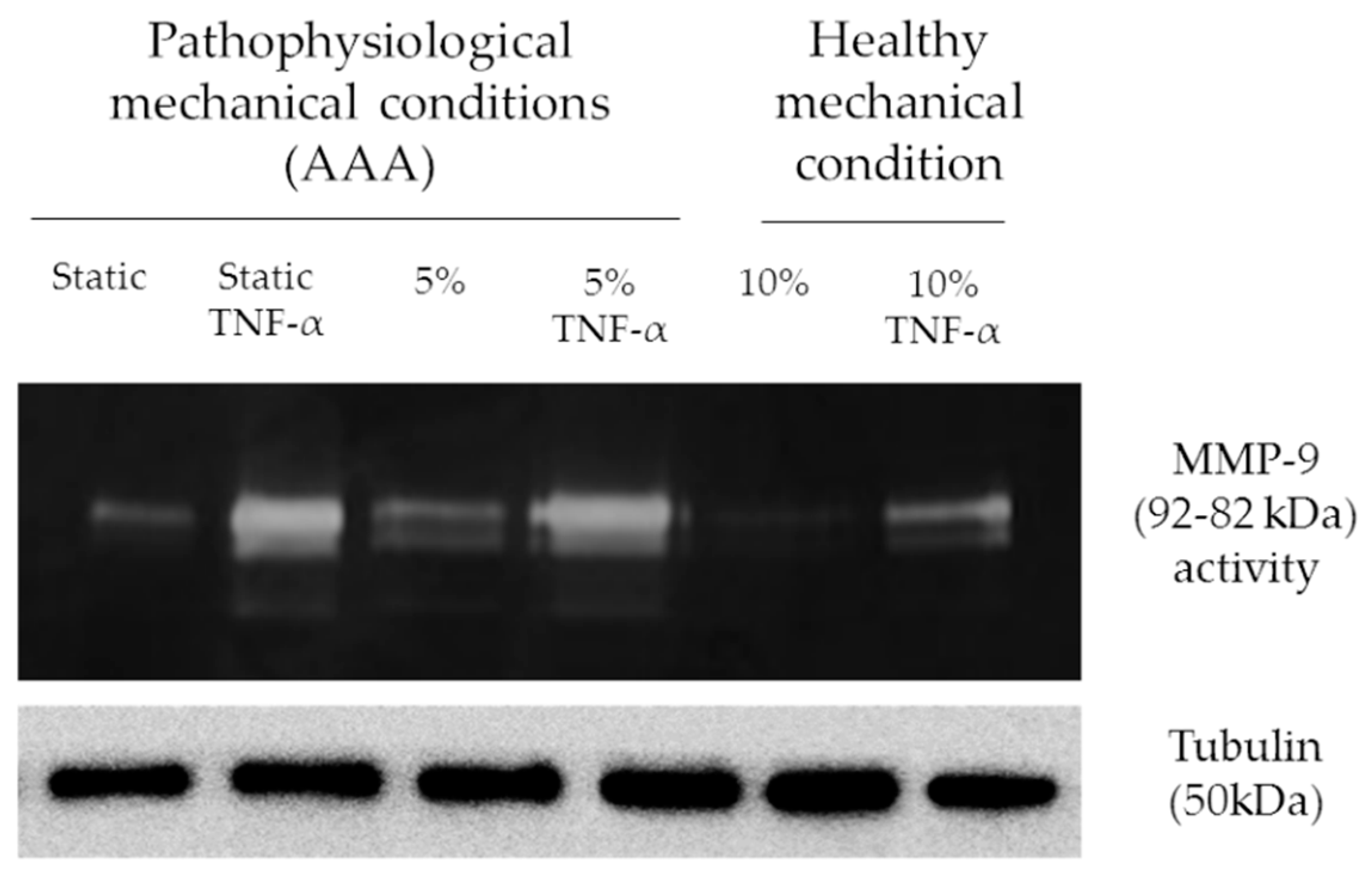
| Protein | Accession Name | Fold Change (p-Value < 0.05) AAA/Healthy | Biological Function |
|---|---|---|---|
| Protein disulfide-isomerase | PDIA1_HUMAN | 2.50 | oxidation-reduction process |
| Isoform H14 of Myeloperoxidase | PERM_HUMAN | 3.04 | oxidation-reduction process |
| Superoxide dismutase [Mn], mitochondrial | SODM_HUMAN | 6.95 | cell response to oxidative stress, oxidation-reduction process, removal of superoxide radicals |
| Ceruloplasmin | CERU_HUMAN | 12.83 | oxidation-reduction process |
| Ferritin heavy chain | FRIH_HUMAN | 21.83 | oxidation-reduction process |
| Ferritin light chain | FRIL_HUMAN | 26.43 | oxidation-reduction process |
| Catalase | CATA_HUMAN | 2.51 | cell response to oxidative stress |
| Low AAC Index | Medium AAC Index | High AAC Index | |
|---|---|---|---|
| calcium deposits | + | ++ | +++ |
| dilatation (%) | 5 < X < 10 | ≃ 5 | X < 5 |
| inflammation | moderate | high | Low |
| ECM remodeling | moderate | high | Moderate |
| Patients | Age Mean ± SD | Gender | DAAA Mean ± SD | Hypercholesterolemia | Smoking | Hypertension | Ischemic Cardiomyopathy |
|---|---|---|---|---|---|---|---|
| Low AAC | 72 ± 4 | Male 100% | 5.6 ± 1.4 | 100% | 33% | 100% | 66% |
| Medium AAC | 75 ± 6 | Male 100% | 5.4 ± 1.3 | 50% | 50% | 88% | 50% |
| High AAC | 71 ±12 | Male 100% | 5.3 ± 0.6 | 100% | 33% | 100% | 66% |
© 2019 by the authors. Licensee MDPI, Basel, Switzerland. This article is an open access article distributed under the terms and conditions of the Creative Commons Attribution (CC BY) license (http://creativecommons.org/licenses/by/4.0/).
Share and Cite
Ramella, M.; Bertozzi, G.; Fusaro, L.; Talmon, M.; Manfredi, M.; Catoria, M.C.; Casella, F.; Porta, C.M.; Boldorini, R.; Fresu, L.G.; et al. Effect of Cyclic Stretch on Vascular Endothelial Cells and Abdominal Aortic Aneurysm (AAA): Role in the Inflammatory Response. Int. J. Mol. Sci. 2019, 20, 287. https://doi.org/10.3390/ijms20020287
Ramella M, Bertozzi G, Fusaro L, Talmon M, Manfredi M, Catoria MC, Casella F, Porta CM, Boldorini R, Fresu LG, et al. Effect of Cyclic Stretch on Vascular Endothelial Cells and Abdominal Aortic Aneurysm (AAA): Role in the Inflammatory Response. International Journal of Molecular Sciences. 2019; 20(2):287. https://doi.org/10.3390/ijms20020287
Chicago/Turabian StyleRamella, Martina, Giulia Bertozzi, Luca Fusaro, Maria Talmon, Marcello Manfredi, Marta Calvo Catoria, Francesco Casella, Carla Maria Porta, Renzo Boldorini, Luigia Grazia Fresu, and et al. 2019. "Effect of Cyclic Stretch on Vascular Endothelial Cells and Abdominal Aortic Aneurysm (AAA): Role in the Inflammatory Response" International Journal of Molecular Sciences 20, no. 2: 287. https://doi.org/10.3390/ijms20020287
APA StyleRamella, M., Bertozzi, G., Fusaro, L., Talmon, M., Manfredi, M., Catoria, M. C., Casella, F., Porta, C. M., Boldorini, R., Fresu, L. G., Marengo, E., & Boccafoschi, F. (2019). Effect of Cyclic Stretch on Vascular Endothelial Cells and Abdominal Aortic Aneurysm (AAA): Role in the Inflammatory Response. International Journal of Molecular Sciences, 20(2), 287. https://doi.org/10.3390/ijms20020287







